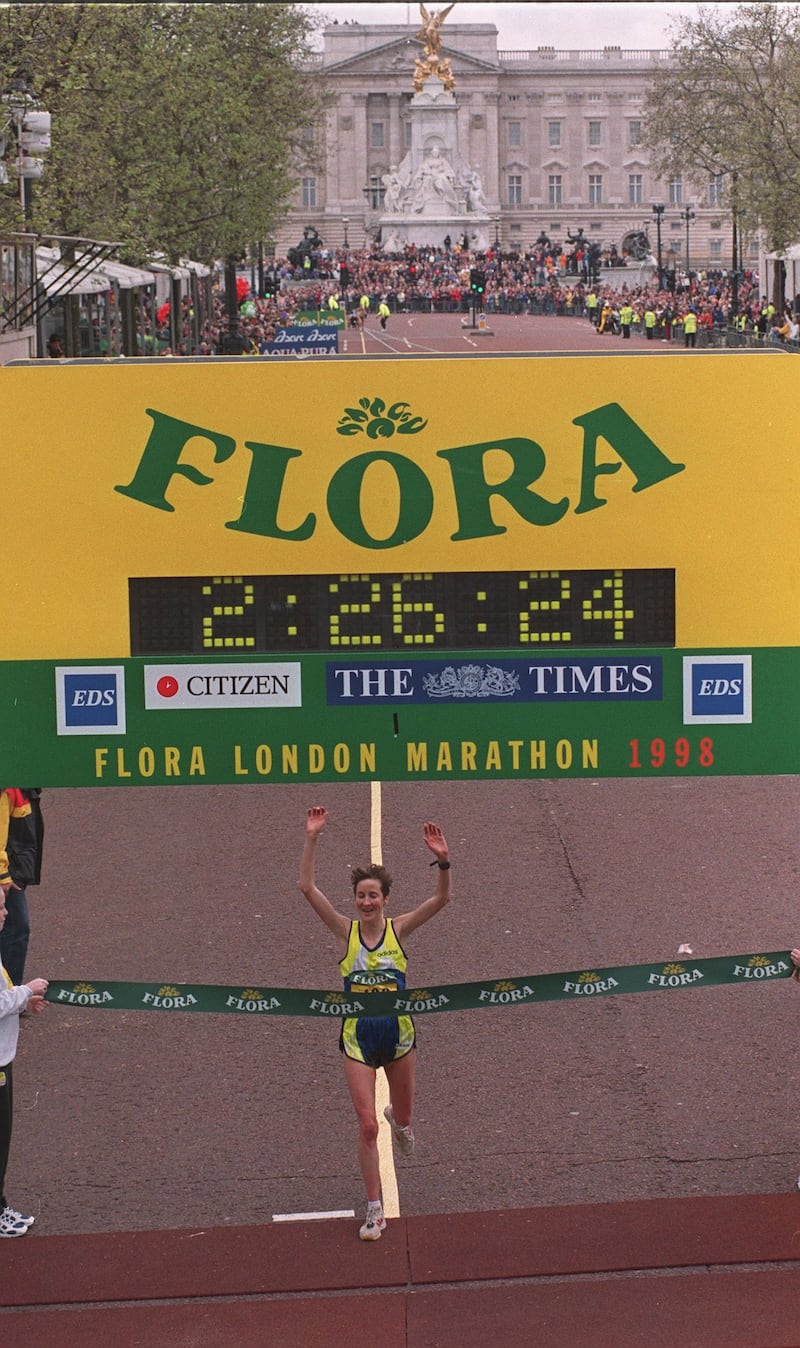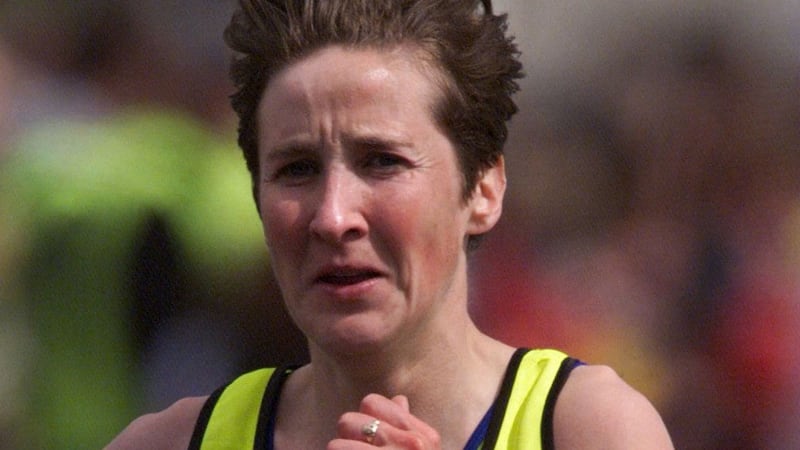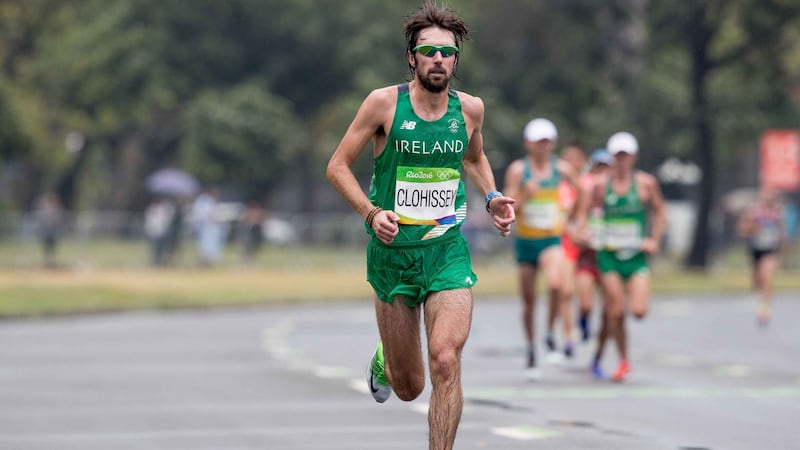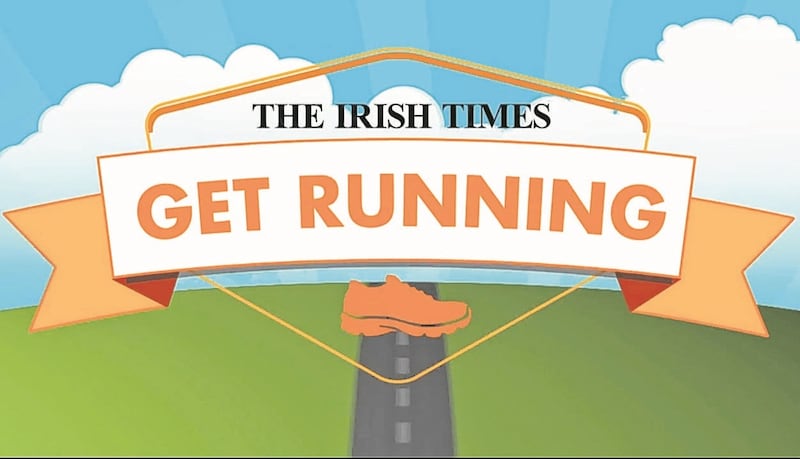The running boom of the 1970s saw races for perhaps only dozens of well-trained club athletes evolve into the present day mass-participation events for many thousands. There has also been a trend for contemporary marathon runners to drink more than their counterparts in the 1970s and 1980s.
For example, former Northern Ireland marathon champion John McLaughlin told The Irish Times: "I ran several AAA marathons in the 1970s and back then the rule was that the first feeding station was at six miles and the rest at five mile intervals thereafter. You were liable to be disqualified if you drank before six miles. I was more interested in sponging down with water in marathons than drinking."
When Ron Hill won the 1970 Edinburgh Commonwealth Games marathon in 2:09:28 he drank nothing and lost 3.9 per cent of his body weight
When Abebe Bikila won the 1960 and 1964 Olympic marathons he drank nothing; nor did the 1983 London marathon winner Mike Gratton; and when Ron Hill won the 1970 Edinburgh Commonwealth Games marathon in 2:09:28 he drank nothing and lost 3.9 per cent of his body weight.
By contrast, Catherina McKiernan – 1998 London marathon winner, 1994 European cross-country champion and four-time world cross-country silver medallist drank often during races.

"When I was running marathons I drank a 200ml carbohydrate drink every 5km. Developing a strategy for ingesting fluids and energy during the marathon is a crucial step towards success on race day, " she told The Irish Times.
And when 2016 Rio Olympic marathoner and 2015 national cross-country champion Mick Clohisey spoke to The Irish Times, he was training hard for the current World Championships in London.
“I was perhaps slightly casual in my last marathon with regards to what concentration of electrolyte drink I consumed during the race. I had stomach problems, which may have been due to drinking Lucozade that was too heavy for my stomach.”
Clohisey has also started using more dilute electrolyte powders and soluble tablets in his long training runs, which he tolerates better. “I have also,” he adds, “started trying flat Coke for the later stages.”
Both McKiernan and Clohisey advise to start a marathon well hydrated. “A lot of people,” says McKiernan, “take carbohydrate-enriched energy gels during marathons. You need to sip some water after taking a gel to wash it down and help absorption. But don’t wait until race day to try an energy gel. You need to experiment first to see if they suit you,” she says.
Nonelite, recreational runners spend more time on their feet, and where fluid intake is concerned, sustained over-drinking can cause the potentially fatal exercise-associated hyponatremia (EAH), which occurs by drinking abnormally large volumes of fluid during exercise.

The condition was first reported in 1985 by a team led by Prof Timothy Noakes of the University of Cape Town, and there have been at least 14 documented fatalities and 1,600 recorded near-fatalities worldwide. By contrast, no competing athlete has died of dehydration.
According to Prof Noakes, “EAH has only one cause: voluntary over-drinking of any fluids, including sports drinks.” EAH, he explained, causes water retention throughout the body. The organ most affected is the brain since the skull limits its capacity to swell. In EAH with encephalopathy, if the brain swells excessively, the pressure rises, first causing loss of consciousness, often associated with seizures, leading ultimately to death from respiratory arrest.
“The sports drink industry developed a novel disease called ‘dehydration’ and used it to encourage over-drinking,” he says.
“The goal was simple: it had nothing to do with promoting safer exercise. It was a cynical method to increase product sales. Sadly, promoting an abnormal and unphysiological behaviour – drinking to stay ahead of thirst – produced the novel disease, EAH, with tragic consequences. All the evidence, then as now, shows that drinking to thirst is the only safe method during exercise.”
Heat problems
Ireland’s participation in the 1994 World Cup in the United States featured “The Great Water Controversy”, with Jack Charlton haranguing officials to let his players drink water in the oppressive heat. But were Jack’s boys risking dehydration or heatstroke?
Dehydration indicates a reduction in the body’s water content, whereas exertional heat stroke (EHS) is characterised by neuropsychiatric impairment and a high rectal temperature, typically exceeding 40 degrees Centigrade, and the first signs of EHS include collapse, aggressiveness and confusion.
It affects only a few individuals among many thousands of athletes who compete in the same events
It is worth noting that: dehydration does not cause EHS. The condition is caused by an abnormal production of heat within the body, which overwhelms its heat-dissipating mechanisms, and results in the death of 20 per cent of reported cases as a result of heart failure or cerebral oedema. It is a complex condition that is uncommon during prolonged exercise, probably because exercise intensity falls below a threshold needed to activate its onset. It affects only a few individuals among many thousands of athletes who compete in the same events. The majority of cases occur in races shorter than 15km, where dehydration is not a factor
How did the 2016 Rio heat affect Irish Olympic marathoner Clohisey? “It was damp and rather coolish on the day of the marathon so heat wasn’t a major factor. I had been suffering from a virus, which did the damage for me. I think people can underestimate the humidity on Irish summer days and not hydrate enough before a race, whether it is a 10km or a half-marathon.”

In 2010, during an on-stage interview in Belfast with the editor of Irish Runner magazine Frank Greally, Irish running legend John Treacy recalled his run in the first heat of the 10,000 metres at the 1980 Moscow Olympic Games, where his collapse was variously attributed to dehydration and/or heat exhaustion.
“I trained in Ireland and was in fantastic shape. When I got out to Moscow it was incredibly hot, 90 degrees, whereas it had been relatively cold in Ireland, and I wasn’t educated properly in hydration and heat effects. I was . . . full of enthusiasm and I pushed the pace, it turned out that it was so much quicker than the other heat. With one lap to go I hit the curb, I was gone.”
Misnomer
In his landmark publication Waterlogged (2012), Prof Noakes, of the University of Cape Town, explains that the term "heat exhaustion" is a misnomer. Heat exhaustion, he says, describes "the circumstances [heat] in which a person chooses to stop exercising. This is then labelled as exhaustion even though the athlete may have no symptoms or other evidence of illness." In this context it is significant that John Treacy told Greally: "I then managed to get myself sorted out and did the 5,000m heats, qualified, finished 7th in the final. It was a brilliant run."
Interestingly, a review published in the journal Wilderness & Environmental Medicine (2013), stated that EHS was a risk for open-water swimmers during long events in warm water, "attributable to increased exercise intensity, specific body composition of open-water swimmers, and a low potential for convective cooling during swimming". And triathletes should bear in mind that wetsuits can limit the effective dissipation of heat.
Heat acclimatisation involves progressively increasing the intensity and duration of physical activity
A position paper published in the Journal of Athletic Training (2015) recommended that "Individuals should be acclimatised to the heat gradually over seven to 14 days. Heat acclimatisation involves progressively increasing the intensity and duration of physical activity."
The most effective treatment for EHS is immersion in ice-cold water for 20 to 30 minutes, which conducts heat from the athlete’s skin and muscles to the water.
Running marathons abroad: top tips
Running a marathon abroad is becoming an increasingly popular activity. If you’re competing abroad, and assuming you have trained well before setting off, what can we learn from elite athletes?
Clohisey provides some reassurance about losing fitness while travelling. “Don’t worry about feeling tired and sluggish. It’s part of your body preparing itself for the effort ahead. I tend to feel this way before big races, and it seems to be a subconscious way of your body storing up energy. Don’t worry about being lazy, enjoy the extra rest! You won’t lose fitness in a week. Trust in your training.”
By the time it was finished I was very hungry, the last thing you want the day before a marathon
McKiernan’s experience before her famous 1998 London marathon victory proves that all is not lost even if you have a mishap. “I flew over the morning before the race, and had to go directly from the airport to the BBC television studios for an interview. By the time it was finished I was very hungry, the last thing you want the day before a marathon. We went to a restaurant and I ordered a plate of plain pasta, but when it arrived it had some kind of sauce on it. Not wanting to cause a scene, I ate the pasta, thinking that the sauce didn’t taste great. Next day at around 15 miles into the race my stomach started to rumble, and I remembered the pasta sauce.
“For the next door miles the cramping got worse, and I had to work hard psychologically to block out the pain, but I had trained so hard for this race and was determined to win. Thank God my stomach settled in the last two miles and I stormed home to a famous victory.”
McKiernan and Clohisey emphasise the importance of sleep, and sub-three-hour marathoner and consultant neurologist Dr Kirstie Anderson, of the Newcastle Regional Sleep Service, is one of the UK's top sleep experts. "Any journey with less than a two-hour time change probably won't be troublesome. In terms of which travel direction disrupts sleep most, east is a beast and west is best! Jet lag following a westward flight is more easily accommodated because our body clock shifts slowly, and since flying west adds more time to our day we've longer to adjust, unlike when flying east," say Dr Anderson.
Don't drink the tap water if not used to it in a particular country
Clohisey says that we shouldn’t underestimate how dehydrated the whole airport experience can leave you. “Ensure you’re well hydrated, and don’t drink the tap water if not used to it in a particular country.”
McKiernan says that autumn and spring are the best times to run a marathon, as the weather is perfect for those who want to cover the distance. “Also,” she adds, “combining an international marathon with travel is a great way to visit other countries. Try to give yourself a day or two to recover from the trip and get used to your surroundings, and keep your running gear in your carry-on to avoid the risk of it getting lost. And once you are at your destination and booked into the hotel, it’s nice to go out for a walk or a nice gentle jog, to loosen the legs and free your mind. This will help you recover from the flight.”
Most important of all, enjoy the experience.

Sign up for one of The Irish Times' Get Running programmes (it is free!).
First, pick the programme that suits you.
- Beginner Course: This programme is an eight-week course that will take you from inactivity to being able to run 30 minutes non-stop.
- Stay On Track: The second programme is an eight-week course for those of you who can squeeze in a 30- to 40-minute run three times a week.
- 10km Course: This is an eight-week course designed for those who can comfortably run for 30 minutes and want to move up to the 10km mark.
Best of luck!



















